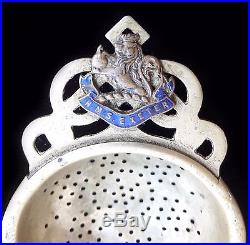
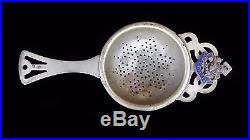
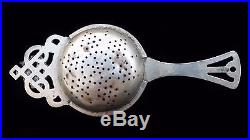
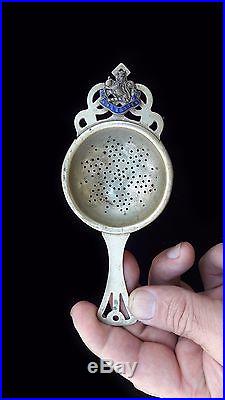
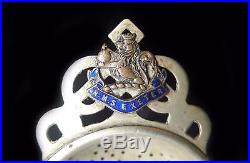
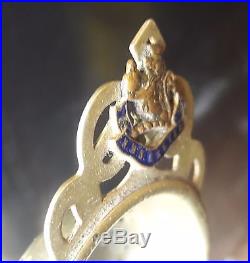
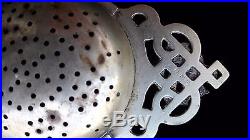
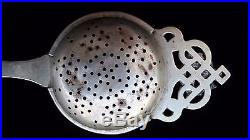
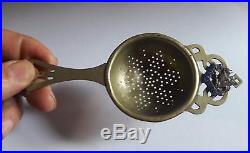
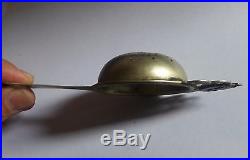
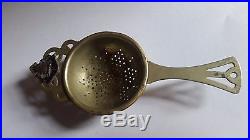
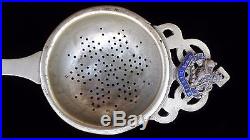

HMS Exeter , British Roya Navy York Class. Very rare piece of metal epns Tea strainer. Diameter : 5,7 cm. Was the second and last. During the late 1920s. Aside from a temporary deployment with the. Of 193536, she spent the bulk of the 1930s assigned to the. North America and West Indies Station. Was one of three British. That fought the German. Later that year in the. Battle of the River Plate. She was extensively damaged during the battle and was under repair for over a year. After the start of the Pacific War. Exeter was generally tasked with escorting convoys to and from Singapore. During the Malayan Campaign. Later that month, she was assigned to the Striking Force of the joint American-British-Dutch-Australian Command. And took on a more active role in the defence of the Dutch islands. The culmination of this was her participation in the Battle of the Java Sea. Later in the month as the Allies attempted to intercept Japanese invasion convoys. Exeter was crippled early in the battle and did not play much of a role as she was forced to withdraw. Two days later, she attempted to escape inbound Japanese forces, but was intercepted and sunk by Japanese ships at the beginning of March in the Second Battle of the Java Sea. Most of her crew survived the sinking and were rescued by the Japanese. About a quarter of them died during captivity. Her wreck was discovered in early 2007 and by 2016 had been destroyed by illegal salvagers. Damage received by Exeter during the Battle of the River Plate. At the outbreak of the Second World War. She formed part of the South American Division. With the heavy cruiser Cumberland. Was assigned to Force G to hunt for German commerce raiders off the eastern coast of South America on 6 October 1939. Three months later, Harwood ordered Exeter and the light cruiser. To rendezvous with his own Ajax. Off the mouth of the River Plate. While Cumberland covered the Falkland Islands. The two other ships arrived on 12 December and Admiral Graf Spee spotted Exeter the following morning. Decided to engage the British and closed at full speed. Langsdorff opened fire at Exeter at 06:18 with high-explosive. The British cruiser with her third salvo. Splinters from the near misses killed the crew of the starboard torpedo tubes and damaged both seaplanes. After eight salvos from Exeter , Admiral Graf Spee scored a direct hit on’B’ turret that knocked it out of action and splinters from the hit killed all of the bridge personnel except three. Bell, wounded in the face, transferred to the aft conning position to continue the battle. At 06:30, Langsdorff switched his fire to the light cruisers, but only inflicted splinter damage on them before some of Exeter. S torpedoes forced him to turn away at 06:37 to evade them. Her second torpedo attack at 06:43 was also unsuccessful. In the meantime, Langsdorff had switched his main guns back to the heavy cruiser and scored several more hits. She remained in action until flooding disabled the machinery for’Y’ turret at 07:30. At 11:07, Bell informed Harwood that Exeter had one eight-inch and a four-inch gun available in local control and that she could make 18 knots (33 km/h; 21 mph). He ordered Bell to head to the Falklands for repair. Exeter was hit by a total of seven 283 mm shells that killed 61 of her crew and wounded another 23. S guns had been put out of action but she was still seaworthy, Bell planned to collide with the enemy, saying I’m going to ram the ——. It will be the end of us but it will sink him too. Several days later, unable to be repaired and apparently confronted by powerful Royal Navy reinforcements, Admiral Graf Spee was scuttled in Montevideo. Exeter made for Port Stanley. For emergency repairs which took until January 1940. She was repaired and modernised at Devonport Dockyard between February 1940 and March 1941; Captain W. Relieved Bell on 12 December 1940. On 10 March 1941, the day Exeter was due to be re-commissioned, Beckett died at Saltash Hospital from complications resulting from surgery related to injuries received earlier in his career. His replacement was Captain Oliver Gordon. On returning to the fleet, she was engaged on escort duty for Atlantic convoys. Including the escort of Convoy WS-8B to the Middle East during the chase for the German battleship Bismarck. Exeter under air attack on 15 February 1942. Upon her arrival at Singapore. On 13 January 1942. Exeter was assigned to the ABDACOM naval force that was intended to defend the Dutch East Indies. (Indonesia) from Japanese invasion. She spent the first several weeks of February escorting convoys in the East Indies. On 13 February, Allied reconnaissance aircraft spotted Japanese invasion convoys north of Bangka Island. And the new commander of ABDA naval forces, Vice Admiral. Of the Royal Netherlands Navy. Was ordered to assemble the Allied Striking Force of Exeter and three Dutch and one Australian light cruisers at Oosthaven. On the morning of 14 February. Escorted by six American and three Dutch destroyers. The force departed that afternoon. The Dutch Rear Admiral. Commanding the force, took his ships through the Gaspar Strait. And then northwest towards Bangka Island. While passing through the strait, the Dutch destroyer Van Ghent. Struck a rock in poor visibility and another Dutch destroyer was tasked to take off her crew. The Japanese spotted the Allied ships around 08:00 and repeatedly attacked them. The first was a group of seven Nakajima B5N. From the light carrier. That attacked Exeter with bombs around 10:30. The blast from a near miss badly damaged her Walrus. They were followed shortly afterwards by a group of 23 Mitsubishi G3M. “Nell” bombers from the Genzan Air Group. That inflicted no damage as they dropped their bombs from high altitude. Another group of six B5Ns attacked without effect at 11:30. The repeated aerial attacks persuaded Doorman that further progress was unwise in the face of Japanese aerial supremacy and he ordered his ships to reverse course and head for Tanjung Priok. The attacks continued as 27 G3Ms of the Mihoro Air Group. Then bombed from high altitude. Seven more B5Ns attacked fruitlessly at 14:30; a half-dozen more followed an hour later. The final attack was made by 17 Mitsubishi G4M. “Betty” bombers of the Kanoya Air Group. In return Allied anti-aircraft fire was moderately effective with most of the attacking bombers damaged by shell splinters. In addition one G4M crashed while attempting to land and another was badly damaged upon landing. First Battle of the Java Sea. Main article: Battle of the Java Sea. On 25 February, Helfrich ordered all available warships to join Doorman’s Eastern Striking Force at Surabaya. Exeter and the Australian cruiser Perth. Escorted by three British destroyers, Jupiter. Set sail at once, leaving behind one Australian cruiser and two destroyers that were short of fuel. After they had arrived the following day, Doorman’s entire force of five cruisers and nine destroyers departed Surabaya at 18:30 to patrol off Eastern Java in hopes of intercepting the oncoming invasion convoy which had been spotted earlier that morning. The Japanese were further north than he anticipated and his ships found nothing. His own ships were located at 09:35 on the following morning, 27 February, and were continuously tracked by the Japanese. Doorman ordered a return to Surabaya at 10:30 and his ships were attacked by eight bombers from the Kanoya Air Group at 14:37. They claimed to have made two hits on Jupiter , but actually missed the British destroyer. Just as his leading ships were entering harbour, he received reports of enemy ships 90 miles (140 km) to the north and Doorman ordered his ships to turn about to intercept them. Aware of Doorman’s movements, the Japanese commander, Rear Admiral Takeo Takagi. Detached the convoy’s two escorting destroyer flotillas. Each consisting of a light cruiser and seven destroyers, to intercept the Allied ships in conjunction with his own pair of heavy cruisers, Nachi. , which were escorted by a pair of destroyers. His heavy cruisers opened fire at long range at 15:47 with little effect. The light cruisers and destroyers closed to ranges between 13,000 and 15,000 yards (12,000 and 14,000 m) and began firing Type 93 “Long Lance” torpedoes. Beginning at 16:03. All of these torpedoes failed to damage their targets, although one torpedo hit Exeter and failed to detonate at 16:35. Aft twin four-inch gun mount before detonating in the forward boiler room. Knocking six of her boilers off-line. And killing 14 of her crew. Out of line to avoid another torpedo and slowed, followed by all of the trailing cruisers. Perth laid a smoke screen. And the Allied ships sorted themselves into separate groups as they attempted to disengage. Exeter was escorted by one Dutch and all three British destroyers in one group and the other cruisers and the American destroyers formed the other group. The Japanese did not initially press their pursuit as they maneuvered to use their torpedoes against the crippled Exeter , which could only make 5 knots (9.3 km/h; 5.8 mph), and her escorts. The Japanese began launching torpedoes beginning at 17:20 at ranges of 10,000 to 18,500 yards (9,100 to 16,900 m), but they all missed. For some reason, two Japanese destroyers continued to close before firing their torpedoes at 6,500 yards (5,900 m) and Encounter and Electra pulled out of line to counter-attack. At close range as they closed. In the meantime, Exeter continued south to Surabaya, escorted by Encounter and the Dutch destroyer Witte de With. Doorman’s repeated, unsuccessful, and ultimately fatal, attempts to reach the transports concentrated the Japanese on the task of protecting the transports and allowed the damaged British cruiser to reach harbour. Second Battle of the Java Sea. Main article: Second Battle of the Java Sea. Exeter sinking after the Second Battle of the Java Sea. The following day, after making temporary repairs and refuelling, Exeter , escorted by Encounter and the American destroyer Pope. Was ordered to sail to Colombo. Via the Sunda Strait. They departed on the evening of 28 February, but were intercepted by the Japanese heavy cruisers Nachi , Haguro , Myk. And the destroyers Akebono. On the morning of 1 March. About 08:00, the British ships spotted two of the Japanese cruisers, one of which launched its spotting floatplanes. Two others were seen closing in, and both launched their aircraft before opening fire at about 09:30. The Allied ships laid smoke and turned away to the east with the Japanese to their north and south. Exeter was able to reach a speed of 26 knots (48 km/h; 30 mph). Before the first hit on her again detonated in a boiler room and knocked out all power around 11:20. The Japanese destroyers closed in and fired a total of 18 torpedoes, which made a number of hits. Two of those from the destroyer Inazuma were claimed as hits. And Exeter quickly capsized. Encounter and Pope were also lost; Pope temporarily survived the initial melee, only to be sunk by B5Ns a few hours later. The Japanese rescued 652 of Exeter. S crew, including her captain, who became prisoners of war. Of these men, 152 died in captivity. The item “WW2 HMS Exeter, British Roya Navy sinking of the German Ship Graf spee” is in sale since Thursday, October 05, 2017. This item is in the category “Collectibles\Militaria\WW II (1939-45)\Original Period Items\Great Britain\Other British WWII Orig. Items”. The seller is “mar_giro2005″ and is located in Montevideo. This item can be shipped worldwide.
- Country/Region of Manufacture: United Kingdom

